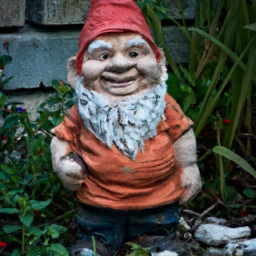Throughout history, various cultures have believed in the existence of a mythical creature similar to the gnome. These beings are believed to be connected to the earth and plants. According to legend, if a gnome is exposed to daylight, it will transform into a stone. The first garden gnomes were created in Germany during the 19th century using terracotta. A few of these gnomes found their way to England, where local craftsmen began replicating them. Nowadays, garden gnomes have gained immense popularity and are believed to tend to your garden during the night. Additionally, there are even mock-political movements advocating for the rights of gnomes.
To delve deeper into gardening superstitions, you can watch this video: Garden Superstitions – Family Plot.
To stay updated with more gardening videos like these, be sure to subscribe to Family Plot on YouTube!
For further information, visit https://www.familyplotgarden.com. “The History of Garden Gnomes – Family Plot” is a video by Family Plot that explores the fascinating origins and legends surrounding garden gnomes. These mythical creatures, associated with soil and plants, are found in various cultures worldwide. According to legend, gnomes turn to stone if they come above ground in the daylight. The first garden gnomes were made of terracotta in Germany in the 1800s, and their popularity spread to England. Today, garden gnomes are beloved for their role in taking care of gardens at night, and there are even faux-political movements centered around gnome rights. Watch this engrossing video for more insights into gardening superstitions and the history of these whimsical creatures.
In the video, the host discusses the interesting history of gnomes and their connection to the mysticism and legends of many countries. He explains that gnomes, known as leprechauns in Ireland, are earth dwellers associated with good luck and treasure-keeping. In the garden, they are believed to come alive at night and take care of the plants. The origin of garden gnomes can be traced back to Germany, where the first terracotta statues were created. These little menfolk eventually made their way to the United Kingdom, becoming the ancestors of the gnomes we know today. The video also mentions the existence of the Gnome Liberation Front, a humorous movement in France and England, where people have a deep passion for gardening. With their rich history and cultural significance, gnomes continue to captivate our imaginations and add charm to our gardens. So, if you’re curious about garden superstitions or enjoy the enchantment of gnomes, make sure to watch this captivating video by Family Plot.
History of Garden Gnomes
Origins in Germany
The history of garden gnomes can be traced back to Germany, where they first emerged in the early 19th century. These whimsical creatures were initially created as decorative statues made from clay or porcelain. Garden gnomes were inspired by the folklore of the Germanic people, who believed in the existence of small, earth-dwelling creatures called gnomes.
Introduction to England
In the mid-19th century, garden gnomes made their way across the English Channel and became popular in England. The fascination with garden gnomes quickly spread, and they began to appear in gardens all over the country. The English embraced the charm and whimsy that these statues brought to their outdoor spaces, seeing them as a way to add a touch of fantasy to their gardens.
Popularity and Cultural Significance
Over time, garden gnomes gained popularity not only in Germany and England but also in many other parts of the world. These delightful and quirky statues became a symbol of folklore and tradition, representing the connection between humans and nature. Garden gnomes became not just garden decorations but also beloved household icons, captivating the imagination of people young and old.
Mythological Background
Gnomes as Earth People
Gnomes are often depicted as small, bearded creatures wearing pointed hats and dwelling deep underground. In folklore, they are believed to be guardians of the earth and protectors of hidden treasure. Gnomes are said to possess magical powers connected to nature, particularly in their ability to control plant growth and the earth’s fertility. They are considered earth-dwelling creatures, reflecting humanity’s deep connection to the land and its resources.
Belief in Turning to Stone
One fascinating belief associated with gnomes is that they have the ability to turn into stone when they are observed by humans. This belief originated from people claiming to have witnessed the sudden immobility of garden gnome statues. Some believe that this petrification is a gnome’s way of protecting themselves from human interference or simply a magical characteristic attributed to them in folklore.
Gardening Superstitions
Garden Superstitions
Gardening has long been steeped in superstitions, and garden gnomes are no exception. Many gardeners believe that having a garden gnome in their garden brings good luck and wealth. They are seen as guardians of the garden, warding off harmful spirits and ensuring the growth and prosperity of plants. Some superstitions even suggest that if a garden gnome is placed in a particular spot, it can ward off pests and promote the health of the garden.
Garden Superstitions Video
For a fun and informative look at some of the most fascinating gardening superstitions, check out the Garden Superstitions Video on our website. You’ll discover the quirky beliefs held by gardeners throughout history and gain insights into the magical world of gardening folklore. So grab a cup of tea, sit back, and enjoy this entertaining journey into the realm of garden superstitions.
Gnome Rights Movement
Faux-Political Movements
Believe it or not, there have been faux-political movements advocating for the rights of garden gnomes. These humorous campaigns call for equal treatment and respect for these iconic garden decorations. While not intended to be taken seriously, these movements serve as a light-hearted reminder of the joy and whimsy that garden gnomes bring to our lives.
Gnome Liberation Front
Perhaps the most well-known faux-political movement is the Gnome Liberation Front. This movement, founded in the 1980s, humorously advocates for the freedom of garden gnomes from their garden confinement. These self-proclaimed gnome activists engage in various activities, such as “kidnapping” garden gnomes and setting them free in parks or natural areas. Although it’s all in good fun, the Gnome Liberation Front has become a symbol of the love and reverence many people have for these charming garden statues.
Gnome Characteristics
Equivalent of Gnomes in Other Cultures
While garden gnomes are most commonly associated with Germanic folklore, similar mythical creatures can be found in various cultures around the world. For example, in Scandinavian folklore, there are creatures called “nisse” or “tomte” that bear a striking resemblance to gnomes. These mischievous beings are believed to protect the home and bring good luck to its inhabitants. Similarly, in Slavic folklore, creatures known as “domovoi” fulfill a similar role, guarding households and helping with domestic chores.
Comparison to Elves and Dwarves
Gnomes are often confused or associated with other mythical creatures such as elves and dwarves. While they may share some similarities, gnomes have distinct characteristics that set them apart. Unlike elves, who are commonly associated with forests and magic, gnomes have a stronger connection to the earth and are usually depicted working in gardens or mines. Similarly, gnomes differ from dwarves, who are typically portrayed as stout and skilled craftsmen. Gnomes, on the other hand, are known for their green thumbs and expertise in gardening.
Association with Good Luck
One enduring belief surrounding garden gnomes is their association with good luck. It is believed that having a garden gnome in your garden or home can bring fortune, prosperity, and protection. Whether it’s warding off evil spirits or simply bringing a sense of joy and whimsy, garden gnomes have long been seen as harbingers of positive energy. Many people feel that a garden gnome’s presence can bring a sense of peace and serenity to their outdoor space.
Gnomes in the Garden
Legends and Myths
Throughout history, various legends and myths have emerged surrounding garden gnomes. Some tales speak of gnomes assisting humans in caring for their gardens, whispering magical secrets to help plants grow and thrive. Other stories depict gnomes as mischievous creatures who play tricks on humans but ultimately bring laughter and joy. These tales have fueled the fascination with garden gnomes and their place in our gardens and folklore.
Function as Garden Caretakers
One of the main roles ascribed to garden gnomes is that of a caretaker for the garden. Their presence is believed to protect the plants and help them flourish. Whether it’s tending to flower beds, pruning shrubs, or even chasing away pests, garden gnomes are seen as diligent and dedicated guardians of the garden. Many gardeners see the inclusion of a garden gnome in their outdoor space as a way to honor the spirit of nature and invite a touch of magic into their lives.
Preference for Darkness and Nighttime
Garden gnomes are often associated with nighttime and darkness. Many gnomes are depicted holding lanterns or lamps, suggesting that they are most active when the sun goes down. This preference for darkness is believed to be connected to their role as protectors of the garden. By being active during the night, when pests and potential threats are more likely to emerge, garden gnomes maintain a watchful eye over the plants and maintain harmony in the garden.
Terracotta Gnomes
German Origins
Terracotta gnomes, also known as clay or ceramic gnomes, have their origins in Germany, where they were initially crafted by skilled artisans. These statues were typically made from terracotta clay, which gave them a rustic and timeless appeal. The use of terracotta allowed for intricate details and vibrant colors, making these gnomes true works of art.
Introduction to England
In the 19th century, terracotta gnomes made their way to England, where they became highly sought-after garden ornaments. The English embraced these charming figures, incorporating them into their gardens and landscapes. Terracotta gnomes quickly became a staple in English gardens, symbolizing the bond between humans and nature.
Original Artist and Terracotta Statues
The original artist credited with popularizing terracotta gnomes is Sir Charles Isham, an English landowner. Isham created colorful and whimsical terracotta statues for his garden at Lamport Hall in the late 19th century. These statues captured the imagination of many, inspiring others to replicate and distribute similar garden gnomes. Isham’s contributions to the history of terracotta gnomes laid the foundation for their enduring popularity as garden decorations.
Notable Gnomes
Lumpy, the Last Survivor
Among the vast array of garden gnomes, one particularly notable figure is Lumpy, the Last Survivor. Lumpy is believed to be the last gnome from the ancient gnome kingdom, the hidden realm of these mythical creatures. According to folklore, Lumpy was captured and brought into the human world, where he now resides as a lone survivor. This legendary gnome has inspired many stories and is a symbol of resilience and the enduring spirit of garden gnomes.
Insurance and Valuation of Gnomes
In recent years, the concept of insuring and valuing garden gnomes has gained popularity. Some collectors and enthusiasts have gone to great lengths to protect their valuable gnome collections. Insurance policies specifically tailored for garden gnome collections are now available, reflecting the cultural significance and sentimental value these statues hold. Valuation of antique gnomes has also become a niche market, with experts appraising and apprising these unique and cherished objects.
Gnomes in Popular Culture
Representation in Movies and Media
Garden gnomes have infiltrated popular culture, often appearing in movies, television shows, and even video games. Films such as “Gnomeo & Juliet” and “Sherlock Gnomes” have brought these lovable characters to life on the big screen, capturing the hearts of audiences of all ages. Additionally, television shows and commercials frequently feature garden gnomes, capitalizing on their iconic status as playful and whimsical beings.
Use as Computer System Names
Garden gnomes have even made their way into the world of technology. In the realm of computer systems and programming, it is not uncommon to find references to garden gnomes. Companies and developers often use gnome-related names for various systems, showcasing the enduring presence and cultural significance of these beloved creatures.
Conclusion
Garden gnomes have a rich history and an enduring appeal that transcends cultures and generations. From their origins in Germany to their introduction to England and subsequent global popularity, these whimsical statues have captivated the hearts and imaginations of people worldwide. Their association with folklore, gardening superstitions, and notions of good luck has further solidified their place in our lives. Garden gnomes continue to enchant us with their charm and bring joy to our gardens and homes. As they evolve and adapt in popular culture, their significance as symbols of tradition and wonder persists, ensuring their continued interest and adaptation for generations to come.


